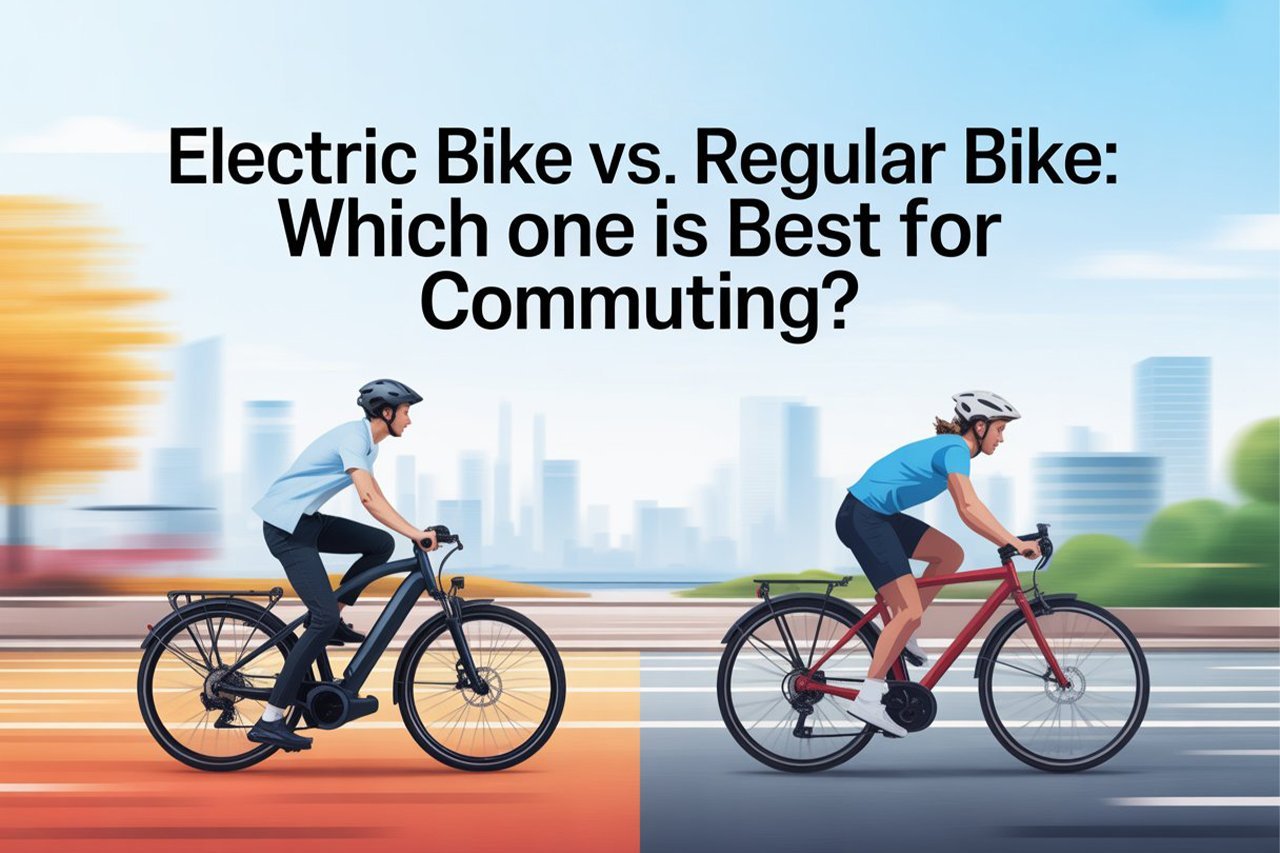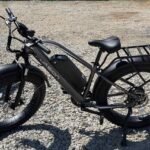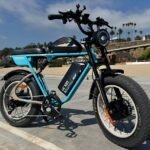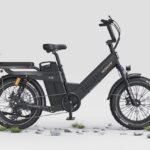
Commuting to work or school has changed dramatically in the last decade, with city dwellers and suburbanites alike searching for faster, more efficient, and enjoyable ways to get around. Two popular options—electric bikes (e-bikes) and regular bikes—stand out for their convenience, affordability, and positive impact on health and the environment. But when it comes to your daily commute, which of these two-wheeled vehicles is truly the better choice?
On the one hand, electric bikes are gaining serious traction. They combine human pedal power with an electric motor, promising a sweat-free, speedy ride even on tough routes. On the other hand, regular bikes—simple, time-tested, and maintenance-light—remain a beloved, healthy way to navigate city streets and rural roads. Each brings a unique set of strengths and limitations to the table.
If you’re torn between these options, you’re not alone. In this in-depth comparison, we’ll break down all the key factors—from cost to convenience, speed, comfort, environmental impact, and more—to help you confidently decide which is best for your daily commute.
Electric Bike vs. Regular Bike – How We’ll Compare Them
Choosing between an e-bike and a traditional bicycle for your commute isn’t just about speed or price. It’s about finding the option that fits your lifestyle, budget, and needs. Here are the main factors we’ll compare:
- Purchase Cost and Ongoing Expenses
- Ease of Use & Accessibility
- Speed and Efficiency
- Physical Effort and Fitness Benefits
- Comfort and Ride Quality
- Range and Versatility
- Maintenance Needs
- Environmental Impact
- Storage and Security
- Urban Practicality (Traffic, Regulations)
- Fun Factor
Let’s dive into each comparison factor in detail.
Purchase Cost and Ongoing Expenses
Electric Bike
Electric bikes are a serious investment upfront. On average, a decent commuter e-bike will set you back anywhere from $900 to $3,000 or more, depending on battery capacity, motor power, brand reputation, and included features. In addition to the initial outlay, you’ll need to factor in recurring costs for battery replacement (every 2-5 years), occasional electrical repairs, and increased insurance or registration in some cities. Charging an e-bike is cheap—just pennies per full charge—but over time, maintenance and parts can add up. Score: 6/10
Regular Bike
Traditional bikes shine in this department. A solid commuter bike from a reputable brand typically costs $300-$800, and basic models can be found for even less. Upkeep is straightforward and parts are widely available and affordable. There are no batteries to replace, and repairs can often be handled at home or at any bike shop. Overall, the lifetime cost of owning a regular bike is lower, especially if you ride often. Score: 9/10
How They Compare
There’s no doubt—if you’re looking to save money both upfront and long-term, a regular bike wins. The lower purchase price and minimal ongoing expenses make it the best option for budget-conscious commuters or those new to cycling.
Ease of Use & Accessibility
Electric Bike
Modern e-bikes are designed to be approachable for all ages and fitness levels. With multiple pedal-assist modes and, in many cases, a throttle, you can adjust the level of help you get from the motor. Steep hills, headwinds, and long distances are no longer daunting. For older riders, people with joint issues, or anyone who hasn’t ridden in a while, an e-bike offers confidence and comfort, making cycling accessible to almost everyone. Score: 9/10
Regular Bike
While regular bikes are user-friendly, they do require a base level of fitness, especially for hilly routes or long commutes. New riders might struggle with stamina or feel intimidated by city cycling, and physical limitations can restrict use. However, once you’re used to it, riding a traditional bike is straightforward and simple, without needing to think about battery levels or electronic systems. Score: 7/10
How They Compare
E-bikes are more accessible, especially for those who aren’t already active or have physical limitations. They make cycling possible for many people who might not otherwise consider it.
Speed and Efficiency
Electric Bike
Speed is where e-bikes really shine. Most commuter e-bikes easily reach 20–28 mph (32–45 km/h) with pedal assistance. This extra speed, especially over longer distances or through traffic, can cut significant time off your daily commute. You can keep pace with city traffic, take longer routes, and arrive at work less sweaty and stressed. Stop-and-go situations are less taxing since the motor gives instant acceleration. Score: 10/10
Regular Bike
On a regular bike, most commuters average 12–16 mph (19–25 km/h), depending on fitness, route, and traffic. Uphill climbs and headwinds slow you down, and you’ll expend much more effort accelerating from stops. For short urban commutes, the time difference may be negligible, but over longer distances or more challenging routes, a regular bike is typically slower and requires more stamina. Score: 7/10
How They Compare
E-bikes provide a major speed advantage for most riders. If getting to your destination quickly (and reliably) is your priority, e-bikes are the clear winner.
Physical Effort and Fitness Benefits
Electric Bike
One common myth is that e-bikes “do all the work.” In reality, you can choose your effort level. You’ll still be pedaling—just with help. On lower assist levels, you’ll get a decent workout, but on higher settings or when using the throttle, you might not break a sweat at all. For those looking to ease into cycling, or who have physical challenges, e-bikes are fantastic. However, if you want the maximum cardiovascular or strength benefit, they don’t compare to the workout you get from a regular bike. Score: 7/10
Regular Bike
A regular bike is pure human power. Every hill, every sprint, every long ride is an opportunity to build fitness, burn calories, and improve cardiovascular health. If your main goal is to get fit or stay active, nothing beats a traditional bike. Regular, moderate-intensity cycling is one of the best ways to maintain a healthy body and mind. Score: 10/10
How They Compare
If you want your commute to double as your daily exercise, the regular bike is the clear winner. But if you want flexible effort or less physical strain, e-bikes offer that flexibility.
Comfort and Ride Quality
Electric Bike
Most commuter e-bikes are designed with comfort in mind: wide saddles, upright riding positions, and built-in suspension are common. The electric assist smooths out rough rides, and you’ll never dread a long or hilly commute. However, e-bikes are heavier—often 20–30kg—making them harder to carry up stairs or maneuver when parking. Some entry-level models may compromise on comfort to keep prices low. Score: 8/10
Regular Bike
Comfort varies greatly among regular bikes. High-quality commuter and city bikes offer upright positions and plush seats, but racing or mountain bikes can be uncomfortable for long city rides. The lighter weight makes handling and carrying a breeze, but on rough roads or steep climbs, you’ll feel every bump and effort. Still, comfort-focused regular bikes are readily available and usually lighter than e-bikes. Score: 8/10
How They Compare
Both can be very comfortable if you choose the right model for your body and commute. The e-bike has an edge for long or hilly routes, but a well-chosen regular bike can be just as pleasant.
Range and Versatility
Electric Bike
E-bikes are limited by their battery range. Most commuter models can travel 25–60 miles (40–100 km) on a single charge, depending on assist level, terrain, and rider weight. If your commute is longer, or you forget to charge, you might run out of juice—but you can always pedal like a regular bike (with more effort due to weight). E-bikes are incredibly versatile: they handle long rides, cargo, and even kid seats with ease, expanding your range of possibilities. Score: 8/10
Regular Bike
The only limit here is your own endurance. With no batteries, you can ride as far as your legs can take you—no recharging required. Regular bikes can be fitted with racks, panniers, or child seats, but carrying heavy loads will be more challenging than on an e-bike. For the ultimate in freedom and “anytime, anywhere” riding, regular bikes take the cake. Score: 9/10
How They Compare
E-bikes are perfect for moderate-to-long commutes within their battery range and are superb at handling hills and heavy cargo. Regular bikes are only limited by your own stamina and are always ready to go.
Maintenance Needs
Electric Bike
E-bikes combine all the usual bike maintenance—tire changes, chain lubrication, brake pads—with the complexity of an electric motor, battery, and controller. While most e-bike parts are modular and increasingly reliable, you’ll need to find a shop experienced with e-bikes for electrical issues. Battery care is essential for longevity. Expect slightly higher annual maintenance costs, especially as your battery ages. Score: 6/10
Regular Bike
Simple is better. Regular bikes have fewer parts to maintain, no electronics, and repairs can be done almost anywhere. Spare parts are inexpensive and universal. DIY maintenance is straightforward for most people, keeping ongoing costs and effort low. Score: 9/10
How They Compare
Regular bikes are easier and cheaper to maintain, hands down. E-bikes are getting simpler every year, but still require more attention and specialized care.
Environmental Impact
Electric Bike
E-bikes are a green choice compared to cars, but their batteries and electrical components have a larger environmental footprint than a standard bike. Manufacturing and disposing of lithium-ion batteries requires energy and resources, though many manufacturers now offer recycling programs. On the plus side, e-bikes encourage people to ditch cars, which has a positive impact overall. Score: 8/10
Regular Bike
Nothing beats the low environmental impact of a traditional bike. No batteries, no emissions, minimal manufacturing resources, and virtually no pollutants during use. Over their lifespan, regular bikes are one of the greenest forms of transportation on the planet. Score: 10/10
How They Compare
While both are far greener than driving, regular bikes win for having the lowest possible environmental impact. E-bikes, though, are still a significant improvement over cars and public transport.
Storage and Security
Electric Bike
The higher value of e-bikes makes them a bigger target for theft, and their size and weight complicate storage. Many e-bike owners need secure indoor storage or heavy-duty locks. Some batteries can be removed to charge indoors, but hauling a 25kg bike up apartment stairs is no small task. That said, urban e-bike owners are adapting with creative storage solutions. Score: 6/10
Regular Bike
A lighter, less expensive bike is easier to store in tight spaces, bring inside, or lock up securely. Replacement cost is lower in case of theft. City dwellers with small apartments or limited storage appreciate the portability and peace of mind that comes with a regular bike. Score: 9/10
How They Compare
If you live in an upper-floor apartment or have limited secure storage, regular bikes are far easier to manage. E-bikes are possible but require more planning and investment in security.
Urban Practicality (Traffic, Regulations)
Electric Bike
E-bikes blend in seamlessly with city traffic and can often keep up with cars on side streets. However, local regulations may restrict e-bike speeds, throttle usage, or where you can ride (some cities ban e-bikes from certain bike paths). Licensing and registration are not usually required, but always check your local laws. E-bikes are fantastic in stop-and-go traffic, but you may face extra scrutiny from law enforcement or city officials. Score: 8/10
Regular Bike
Regular bikes are universally accepted on city roads, bike lanes, and trails. There’s rarely any confusion about where you can ride or how fast you can go. No registration, insurance, or licensing needed. In terms of pure simplicity, regular bikes excel in urban environments. Score: 10/10
How They Compare
For hassle-free commuting and regulatory simplicity, regular bikes are the clear winner. E-bikes offer advantages but may come with more rules to navigate.
Fun Factor
Electric Bike
E-bikes inject a sense of adventure into your daily ride. The thrill of acceleration, the freedom to explore further, and the ability to tackle any hill without fear make commuting genuinely fun. They open up cycling to new riders and offer a high-tech edge to the everyday journey. Score: 9/10
Regular Bike
Nothing beats the classic joy of a regular bike. There’s a meditative quality to self-powered travel, and the satisfaction of conquering a tough route under your own steam is unmatched. For those who love a challenge or want to fully engage with the ride, regular bikes are timeless. Score: 8/10
How They Compare
Both are fun in their own ways. E-bikes are exhilarating and accessible, while regular bikes offer a more “pure” cycling experience.
The Breakdown
Here’s a quick look at how electric bikes and regular bikes score across all these categories:
| Comparison Factor | Electric Bike | Regular Bike |
|---|---|---|
| Purchase Cost | 6/10 | 9/10 |
| Ease of Use | 9/10 | 7/10 |
| Speed & Efficiency | 10/10 | 7/10 |
| Fitness Benefits | 7/10 | 10/10 |
| Comfort | 8/10 | 8/10 |
| Range & Versatility | 8/10 | 9/10 |
| Maintenance | 6/10 | 9/10 |
| Environmental Impact | 8/10 | 10/10 |
| Storage & Security | 6/10 | 9/10 |
| Urban Practicality | 8/10 | 10/10 |
| Fun Factor | 9/10 | 8/10 |
| Total Score | 85 | 96 |
The Winner – Regular Bike (But It Depends!)
Based on the scoring above, the regular bike edges out the electric bike as the best all-around choice for most commuters—especially those on a budget, seeking the most environmental benefit, or wanting their daily ride to double as a fitness routine.
But don’t discount the e-bike! For longer, hillier commutes, or for riders who want to arrive sweat-free and fresh (or simply want to avoid the car), the electric bike is a game-changer. It’s easier to use for people of all fitness levels, can save you time, and opens up cycling to a much broader audience.
If you’re young, fit, have a short-to-medium commute, and want a minimal, green, and affordable way to get around, a regular bike is hard to beat. On the other hand, if you value speed, accessibility, or have physical limitations—or if you just want to make your commute more enjoyable—an e-bike could be your perfect match.
In summary:
- Go for a regular bike if cost, fitness, and simplicity are your top priorities.
- Choose an electric bike if you want extra speed, comfort on hills, or the ability to ride longer and arrive fresher.
Both options offer a sustainable, healthy, and satisfying way to navigate the urban jungle. Whichever you pick, your commute (and your life) will likely improve.








